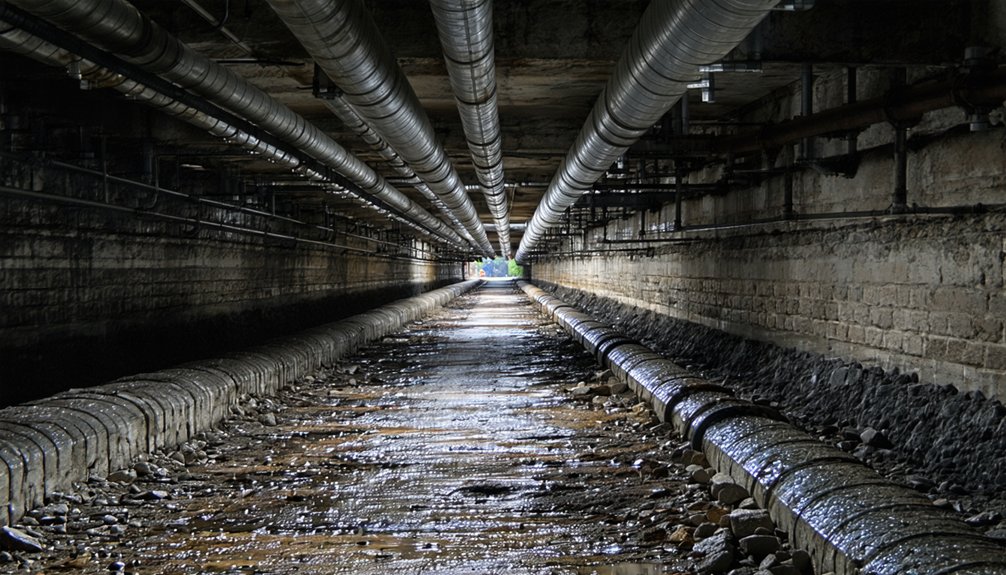Sewer replacement costs can vary greatly due to various influencing factors. The age and condition of existing infrastructure play essential roles, alongside the type of pipe material used. Labor expenses, which can exceed 50% of total costs, are influenced by job complexity and required skills. Additionally, location can complicate accessibility and increase overall expenses. Understanding these variables provides insight into the pricing spectrum, revealing further complexities that warrant exploration.
Factors Influencing Sewer Replacement Costs
When evaluating sewer replacement costs, various factors must be considered to understand the financial implications fully. Key factors in determining sewer line repair costs include the age and condition of existing infrastructure, as older systems often necessitate complete replacements or extensive repairs due to outdated materials. Moreover, the location of the damaged sewer line plays a vital role; urban areas present unique challenges, such as existing utilities that complicate repairs and accessibility, thereby increasing overall costs. The type of material also influences expenses, with cast iron pipes being more susceptible to corrosion and requiring larger replacements compared to more durable options like PVC. Additionally, the extent of damage is paramount; minor sewer line issues may lead to low-cost repairs, while extensive damage may require costly overhauls. Significantly, labor expenses make up a substantial portion of the total cost, often exceeding 50% due to the need for skilled professionals and specialized equipment.
Common Expenses Associated With Sewer Replacement
Understanding the financial landscape of sewer replacement involves examining the common expenses associated with the process. The average cost for sewer line replacement typically ranges from $10,000 to $15,000, greatly influenced by cost factors such as pipe material and line length. Labor expenses constitute over 50% of the total job cost, with installation often requiring 2-3 days. Permit fees, ranging from $250 to $450 for protected roadways, further increase overall expenses. Restoration costs, incurred post-excavation, generally fall between $700 and $1,000, alongside potential additional charges in complex work environments. The intricacies of the work environment, including restricted access and challenging conditions, can elevate labor costs and total project expenses. As a result, engaging a qualified plumbing contractor is essential to navigate these substantial expenditures effectively.
Understanding the Variability in Pricing
Pricing for sewer line replacement exhibits substantial variability, influenced by a multitude of factors that can greatly alter overall costs. The average cost ranges from $3,000 to $25,000, largely determined by the length of pipe needing replacement and the extent of damage. For example, replacing 25-35 feet can cost between $1,250 to $7,000, while longer installations may exceed $25,000. Labor expenses constitute over 50% of total costs, with rates varying from $50 to $500 per hour based on contractor expertise and job complexity. Permitting fees, typically between $200 and $450, can further inflate costs, particularly when coupled with expediting fees. Additionally, accessibility issues or challenges posed by urban infrastructure can complicate repairs, greatly increasing costs, sometimes exceeding $20,000 for repairs extending from the house to the street. These interrelated factors create a complex pricing landscape for sewer line replacement.
Frequently Asked Questions
Why Is Replacing a Sewer Line so Expensive?
Replacing a sewer line can feel like an extravagant affair, akin to purchasing a luxury car. The replacement costs balloon due to digging methods, material choices, and labor expenses, with contractor rates soaring alongside local regulations and inspection fees. Property access challenges further inflate expenses, while environmental impact considerations can add unforeseen costs. In this high-stakes game of plumbing roulette, one must prepare for a financial plunge into the depths of sewer line replacement.
Does Homeowners Insurance Cover Sewer Line Replacement?
Homeowners often find that standard insurance policies do not provide adequate homeowner coverage for sewer line replacements, as many exclude sewer damage from wear and tear. Coverage limits can vary considerably among insurance providers, affecting repair costs. While some policies may cover sudden incidents, the claim process can be complicated by exclusions. Preventive maintenance and adding endorsements may enhance coverage, allowing homeowners to mitigate the financial impact of sewer line failures.
What Is the Cheapest Way to Replace a Sewer Line?
The cheapest way to replace a sewer line involves exploring DIY methods and trenchless technology, which can minimize contractor fees. Cost-saving strategies include selecting durable materials and understanding local regulations to avoid unexpected expenses. Financing options may alleviate upfront costs. Engaging in thorough inspection processes and maintaining the system can prevent future issues. Expert consultations can provide tailored advice, enhancing decision-making and ensuring a practical approach to sewer line replacement without excessive spending.
How Often Do Sewer Lines Need to Be Replaced?
In the intricate dance of urban infrastructure, the sewer line lifespan varies widely, often dictated by maintenance frequency and environmental conditions. Factors such as soil type influence durability, while root intrusion impact can accelerate deterioration. Aging infrastructure concerns necessitate vigilant inspection technology advances, guiding timely replacement scheduling tips. The choice of pipe material durability plays a pivotal role, with traditional installations requiring more frequent updates as they succumb to time's relentless march.



